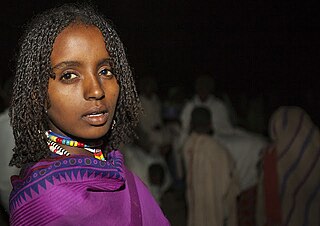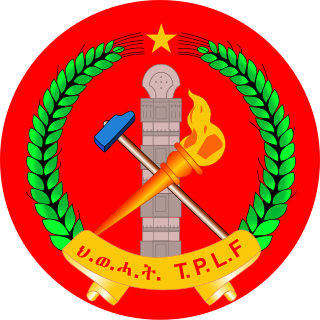Related Research Articles

The Oromo are the largest Cushitic ethnic group native to the Oromia region of Ethiopia and parts of Northern Kenya. They speak the Oromo language, which is part of the Cushitic branch of the Afroasiatic language family. They are one of the largest ethnic groups in Ethiopia. According to the last Ethiopian census of 2007, the Oromo numbered 25,488,344 people or 34.5% of the Ethiopian population. Recent estimates have the Oromo compromising 41,000,000 people, or 35.8% of the total Ethiopian population, estimated at 116,000,000.

The government of Ethiopia is the federal government of Ethiopia. It is structured in a framework of a federal parliamentary republic, whereby the prime minister is the head of government. Executive power is exercised by the government. The prime minister is chosen by the lower chamber of the Federal Parliamentary Assembly. Federal legislative power is vested in both the government and the two chambers of parliament. The judiciary is more or less independent of the executive and the legislature. They are governed under the 1995 Constitution of Ethiopia. There is a bicameral parliament made of the 108-seat House of Federation and the 547-seat House of Peoples' Representatives. The House of Federation has members chosen by the regional councils to serve five-year terms. The House of Peoples' Representatives is elected by direct election, who in turn elect the president for a six-year term.

Oromia is a regional state in Ethiopia and the homeland of the Oromo people. The capital of Oromia is Addis Ababa (Finfinne).

Shewa, formerly romanized as Shua, Shoa, Showa, Shuwa, is a historical region of Ethiopia which was formerly an autonomous kingdom within the Ethiopian Empire. The modern Ethiopian capital Addis Ababa is located at its center.

The Tigray People's Liberation Front, also called the Tigrayan People's Liberation Front, is a left-wing ethnic nationalist, paramilitary group, and the former ruling party of Ethiopia. It was classified as a terrorist organization by the Ethiopian government from May 2021 until its removal from the list in March 2023. In older texts and Amharic publications, it is known as Woyane or Wayane.

The Oromo Liberation Front is an Oromo nationalist political party formed in 1973 to promote self-determination for the Oromo people inhabiting today's Oromia Region and Oromia Zone in the Amhara Region of Ethiopia. The OLF has offices in Addis Ababa, Washington, D.C., and Berlin, from which it operates radio stations that broadcast in Amharic and Oromo.
Ahmad Taqi "Hundee" Sheikh Mohammed Rashid was an Ethiopian Oromo nationalist, known, along with his comrade Elemo Qiltu, as the "first true fighters and martyrs of the Oromo causes". It was these two persons and their few colleagues who founded an organization with a fighting unit that bears the name of the Oromo people, although before them, many nationalists had fought and died for the Oromo causes. In addition, these men are credited with reviving and popularizing usage of the name Oromo in early 1970s.

Ethiopian nationalism, also referred to as Ethiopianism or Ethiopianness, according to its proponents, asserts that Ethiopians are a single nation, and promotes the social equality of all component ethnic groups. Ethiopian people as a whole regardless of ethnicity constitute sovereignty as one polity. Ethiopian nationalism is a type of civic nationalism in that it is multi-ethnic in nature, and promotes multiculturalism.
The Machaa are a subgroup of the Oromo people in western and Central Oromia. They live south of the Blue Nile (Abbai) in the northwestern part of the region of Oromia and in parts of West Shewa Zone, South West Shewa Zone, Oromia Special Zone Surrounding Finfinnee, West Welega Zone, East Welega Zone, Jimma, Jimma Zone, Illubabor Zone, Kelam Welega Zone,Horo Guduru and in parts Amhara Region particularly Gojjam zones. A small group of them lives in the area north of the Blue Nile Wambara in the Benishangul-Gumuz Region.

The presidential election held on 7 October 2013, was the fourth presidential election of the Federal Democratic Republic of Ethiopia to elect the country's third president. Mulatu Teshome was elected by the parliament to a six-year term. Incumbent president Girma Wolde-Giorgis was barred from seeking re-election due to term limits.

Tadesse Birru was an Ethiopian general of the Imperial Ethiopian Army and civil rights activist. Initially a strong proponent of Ethiopian unity, Tadesse eventually became an activist for the empowerment of the Oromo people in the 1960s. His advocacy turned into repeated attempts to overthrow the government through a coup and later through a military rebellion. He was eventually captured and executed by the Derg regime. He is considered to be the father of modern Oromo nationalism.

Hassan Ibrahim, more commonly known by his nom de guerreElemo Qiltu, was an Ethiopian guerilla commander and businessman, a prominent member of the Oromo nationalist movement and one of the first leaders of the Oromo Liberation Army.
Baro Tumsa (1938–1978) was a pharmacist, lawyer and Oromo nationalist and political activist in Ethiopia. He was the younger brother of Reverend Gudina Tumsa and mainly responsible for the formation of the Oromo Liberation Front.

The Oromo conflict is a protracted conflict between the Oromo Liberation Front (OLF) and the Ethiopian government. The Oromo Liberation Front formed to fight the Ethiopian Empire to liberate the Oromo people and establish an independent state of Oromia. The conflict began in 1973, when Oromo nationalists established the OLF and its armed wing, the Oromo Liberation Army (OLA). These groups formed in response to prejudice against the Oromo people during the Haile Selassie and Derg era, when their language was banned from public administration, courts, church and schools, and the stereotype of Oromo people as a hindrance to expanding Ethiopian national identity.

The Hachalu Hundessa riots were a series of civil unrest that occurred in the Oromia Region of Ethiopia, more specifically in the hot spot of Addis Ababa, Shashamene and Ambo following the killing of the Oromo musician Hachalu Hundessa on 29 June 2020. The riots lead to the deaths of at least 239 people according to initial police reports. Peaceful protests against Hachalu's killing have been held by Oromos abroad as well. The Ethiopian Human Rights Commission (EHRC) found in its 1 January 2021 full report that part of the killings were a crime against humanity, with deliberate, widespread systematic killing of civilians by organised groups. The EHRC counted 123 deaths, 76 of which it attributed to security forces.
Music and politics have been closely intertwined throughout the history of Ethiopia.
A neftenya was the name given to Emperor Menelik II's warriors, who were primarily of Shewan Amhara origin, that collected customs and taxes for the Imperial Ethiopian government. In its literal meaning, neftenya, referred to riflemen in the Imperial Ethiopian Army who were known to have settled in Ethiopia's peripheral regions, including parts of present-day Oromia Region, the SNNPR Region, Gambela Region and the Benishangul-Gumuz Region from the late 19th century onwards. The origin of this term lies from the fact that these soldiers, i.e. "neftenya", were granted land on these newly conquered territories, including the services of the indigenous people on these lands, as rewards for their services.

Tigrayan nationalism is an ethnic nationalism that advocates the interests of Tigrayan people in Ethiopia. Inspired predominantly by the Tigray People's Liberation Front (TPLF) with its predecessor Tigray Liberation Front (TLF), this type of nationalism holds that Tigrayans are an independent group with unique ancestry, heritage, history and culture outside Ethiopia. As such, they claim Tigray is the source of Ethiopian civilization and utterly a benefactor of state-building without other local ethnic groups. Tigrayan nationalists accuse Amharas of imposing their cultural, economic and political hegemony over Tigrayans.

The relations between Oromia and Addis Ababa has been great controversy as the subject sparked historical revisionism in the linkage of history of Addis Ababa. The area in the present day Addis Ababa called Finfinne where various Oromo pastoralists inhabited the region, and the emergence of Abyssinian expansionism under Emperor Menelik II which renamed the area as Addis Ababa in 1886. Throughout the 20th century, Addis Ababa was governed as the capital city of the Ethiopia under urban influence.

Anti-Oromo sentiment or Oromophobia, is opposition, hatred, discrimination or prejudice against the Oromo ethnic group. Anti-Oromo sentiment has root its accusations during the rule of Ethiopian Empire, particularly in the reign of Emperor Menelik II in 1880s. Oromo nationalists argued that the Oromo have been subjugated and oppressed by dominant Amhara feudal rulers and its oppression persisted throughout 20th century. Under Haile Selassie, Oromos have been targeted to persecutions after long wave of resistance. Many Oromo revolutionaries like Mamo Mazamir, Haile Mariam Gamada and General Tadesse Birru faced execution by Selassie government and then the Derg regimes.
References
- ↑ Bahru Zewde. Documenting the Ethiopian Student Movement: An Exercise in Oral History . Addis Ababa: Forum for Social Studies, 2010. p. 103
- ↑ About Macha Tulema USA
- ↑ "History".
- ↑ Fessha, Yonatan Tesfaye. Ethnic Diversity and Federalism Constitution Making in South Africa and Ethiopia . Farnham: Ashgate, 2010. p. 173
6. Olana Zoga Bojia. Gizetna Gizot Macha and Tulema Association, Amharic, 1996